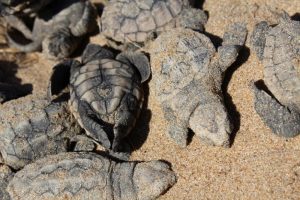Turtle species that exhibit Temperature Dependant Sex Determination are increasingly threatened by rising temperatures. New research points to higher temperatures being responsible for increasing mortality rates in sea turtle hatchlings.
In February 2017, I became a volunteer with The Mon Repos Turtle Conservation Centre, founded by leading marine turtle biologist and ecologist Dr. Col Limpus, whose research over the past 50 years has focused on one of the most important nesting beaches within the South Pacific. Unfortunately my time at Mon Repos coincided with an upwelling high pressure system to the north bringing soaring heat waves into the Bundaberg region, ultimately claiming the lives of hundreds of turtle hatchlings emerging to undertake their maiden voyage out to sea.

Photo: Loggerhead (Caretta caretta) hatchlings that have succumbed to extreme heat immediately after emerging from their nest on Mon Repos Beach, Bundaberg, QLD. (ABC: © Jess Lodge 2017)
Impact of high Temperatures on Turtle Hatchlings
Like many other reptilian species, sea-turtles rely on Temperature-Dependent Sex Determination (TSD) to maintain a viable population. The drawback to this adaptation is that the tolerances these species exhibit against extreme temperatures is very small.
“They can’t sweat, they can’t pant, so they have no mechanism for cooling down,” Dr. Limpus explains to me and the rest of the team. “If they encounter very hot sand they simply heat up and die quickly”. Events like the one witnessed along Mon Repos Beach during the 2016/17 austral summer can push sand temperatures as high as 75̊C, well over the lethal tolerance of all marine turtle species.
In reptilian species that are subject to TSD, males are produced at cooler temperatures, whilst females are produced at higher temperatures. Scientists have long held concerns that rising temperatures will cause an imbalance in sex ratios within populations that exhibit TSD, resulting in a disproportionate number of female individuals. These concerns were validated with the recent finding by Jensen et al. (2018), that almost 100% of juvenile sea-turtles from the northern Great Barrier Reef, were male [1]. Thermal tolerances for these species are, however, also extremely narrow at both ends, resulting in death after a short amount of time when exposed during, or immediately after, incubation.
New research conducted by Laloe et al (2017)[2], has effectively mapped the role of rising air temperatures in sea-turtle hatchling mortality, many species of which are already threatened by human impacts such as ghost nets and plastic pollution. This new study developed a model that incorporated temperature impacts on both hatchling sex and survival, allowing researchers’ to make projections regarding the survival of marine turtle populations over the next century. The model is based on several data-sets obtained by Laloe and his team, who collected information from a vital Loggerhead Turtle (Caretta caretta) rookery along the Cape Verde Islands, 630km west of Senegal, Africa. Laloe et. al, recorded over 6603 days of sand and air temperatures over the course of six years to calibrate the model, facilitating the most accurate projections possible of the future viability of all affected marine turtle species.

Only around 1 in a 1000 hatchlings will make it to adulthood, highlighting the need for more conservation efforts to mitigate the natural and anthropogenic risks. (ABC: © Jess Lodge 2017)
Laloe et al.’s results flagged concerns for species that use TSD in a warming world. Specifically, the results of this long-term research found that hatchling success rates may fall by 49.1% over the course of the century. As global temperatures rise, the thermal limits of hatchling survivorship will be reached resulting in a slow but evident decline in turtle numbers. Since these animals have low fecundity and reach sexual maturity only after 25-30 years, Laloe et al. predict low resilience of marine turtle species and warns against potential extinction for the ever vital wild populations.
In spite of the results of the study, long-term efforts to prevent hatchling mortality have shown to be successful. When witnessing the destruction of the heat wave along Mon Repos Beach, Dr. Limpus and his team quickly adapted to the situation and began constructing shaded hatcheries all along the beach. These shelters gave many hundreds of hatchlings the opportunity to emerge successfully without the effects of the heat. It is likely that as temperatures rise these adaptive management methods must be adopted at all key nesting beaches around the globe.
References
- Jensen, M.P., et al., Environmental Warming and Feminization of One of the Largest Sea Turtle Populations in the World.Current Biology. 28(1): p. 154-159.e4.
- Laloë, J.-O., et al., Climate change and temperature-linked hatchling mortality at a globally important sea turtle nesting site. Global Change Biology, 2017. 23(11): p. 4922-4931.



Recent Comments